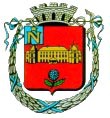-
Introduction
This itinerary takes you on a voyage of discovery, discovery not only of Bonaparte first Consul but also of Josephine the first mistress of Rueil-Malmaison. For it was in effect on her initiative that the château was purchased in 1799 and transformed by the architects Percier and Fontaine into what was to become the couple’s preferred residence during the entire Consulate period. Although Josephine was occasionally elsewhere during the first years of the Empire, Malmaison became her refuge after the divorce in 1809 and it was here that she passed away in 1814.
Set about six miles outside Paris, Rueil-Malmaison is a town steeped in Napoleonic history. But there is more besides. Malmaison is also the charming village which worked its magic on Josephine. This itinerary is designed to be done in a day but those who prefer a leisurely stroll and a pretty walk could take two days or even longer. Come with us on a voyage back in time to a site which today is fragmentary but which under the Empire was a property spreading over nearly a thousand hectares, the Malmaison Estate.
Karine Huguenaud
(July 1996 – trans P.Hicks and others)
-
Route : Malmaison itinerary
The visit begins at the former town hall, today the Municipal Museum of the History of Rueil-Malmaison. Although the museum in itself rival other grander museums, the building is however a Second Empire structure with the imperial eagle on its facade and it sets the perfect historical tone for this itinerary. For it is a building which witnessed Napoleonic epic at close hand, notably: the arrival of the Bonaparte couple at Malmaison under the Consulate; the improvements and changes made to the property during the Empire; Josephine’s return after her divorce; her death and burial; the fate of the Malmaison Estate after her death; and the actions of Napoleon III in favour of the city. “I consider the inhabitants of Rueil as part of my family” declared the Emperor, clearly in reminiscence of the happy childhood days spent with his grandmother at Malmaison. And it was this strong sense of attachment which contributed greatly to the improvement of the quality of life in Rueil under the Second Empire.
On leaving the town hall, take the rue Paul Vaillant-Couturier to the Church Square. Here stands the church of Saint-Pierre-Saint-Paul which, on either side of the chancel, houses the tombs of the Empress Josephine and her daughter, Queen Hortense (Genealogy). Continue by taking the rue Jean Le Coz, across from the church, then the avenue de l’Impératrice Joséphine that leads to the Bois Préau park. Under the Empire, this road was only a large thoroughfare that led directly from the church to the Malmaison Château. Bourienne, one of Napoleon’s secretaries, recounts how Bonaparte liked to walk there, and how if the church bells began to ring he would stand stock-still to listen. On reaching the park gates, and before visiting the museum there, turn right onto the avenue de Bois Préau. At the end of this avenue, at the corner with the avenue Napoléon Bonaparte, there is a beautiful building which is today owned by the French Institute of Petroleum. This is the former guard house, originally situated in the outer Malmaison park, and it was used as the stables and to house the cavalry squadron charged with keeping watch over the estate entrance. Built by Percier and Fontaine in 1801, the original structure is intact despite later additions, such as the rotunda on the right. Noteworthy are the pediment decorated with a military trophy and the Ionic pilasters framing the door.
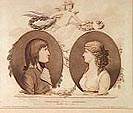 On retracing your steps, you enter the park of the Château Bois-Préau housing a museum dedicated to Bonaparte’s exile on Saint Helena and to the Napoleonic legend. After your visit to the museum, take the main park drive to the Château de Malmaison. Make sure not to miss the stone statue atop a high pedestal on right, because here you must turn right and walk up to the wooden park-guard surveillance cottage. To the right of this hut, follow the path which runs along the edge of the grounds of the beautiful, state-owned Château Oeillets, the house which once belonged to the banker Hagermann, the owner of the estate after Josephine’s death. Today the house is inhabited by the fortunate curators of the Château Malmaison and the Château Bois-Préau. Immediately beyond this, you enter the car-park through a gate in the wall. Just beyond the car-part are the great gates of Château Malmaison.
On retracing your steps, you enter the park of the Château Bois-Préau housing a museum dedicated to Bonaparte’s exile on Saint Helena and to the Napoleonic legend. After your visit to the museum, take the main park drive to the Château de Malmaison. Make sure not to miss the stone statue atop a high pedestal on right, because here you must turn right and walk up to the wooden park-guard surveillance cottage. To the right of this hut, follow the path which runs along the edge of the grounds of the beautiful, state-owned Château Oeillets, the house which once belonged to the banker Hagermann, the owner of the estate after Josephine’s death. Today the house is inhabited by the fortunate curators of the Château Malmaison and the Château Bois-Préau. Immediately beyond this, you enter the car-park through a gate in the wall. Just beyond the car-part are the great gates of Château Malmaison.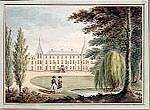 The path which leads to the entrance, with its porch in the form of a military tent, provides a sumptuous sight. Château Malmaison is fascinating for many reasons, notably its interior harmony and the quality of the museum collections, but it is also remarkable also for the moving atmosphere it radiates: here, more than anywhere else, the presence of Bonaparte and Josephine is still perceptible. This impression is particularly strong when visiting the park, where there is the garden which Josephine filled with exotic flora and fauna in memory of her West Indian childhood spent on the La Pagerie estate on Martinique. Of course, the animals have long disappeared, but the Empress’s rose gardens are today the object of ongoing botanical research. The aim is to use Redouté’s descriptions of his own hybrids and contemporary descriptions of the garden so as to recreate the rarest of the species. There are other unusual feature in the park: to the left of the building, next to the garden, Josephine had planted a majestic cedar which was brought back from Magenta as a memorial to the famous battle victory in the Italian campaign.
The path which leads to the entrance, with its porch in the form of a military tent, provides a sumptuous sight. Château Malmaison is fascinating for many reasons, notably its interior harmony and the quality of the museum collections, but it is also remarkable also for the moving atmosphere it radiates: here, more than anywhere else, the presence of Bonaparte and Josephine is still perceptible. This impression is particularly strong when visiting the park, where there is the garden which Josephine filled with exotic flora and fauna in memory of her West Indian childhood spent on the La Pagerie estate on Martinique. Of course, the animals have long disappeared, but the Empress’s rose gardens are today the object of ongoing botanical research. The aim is to use Redouté’s descriptions of his own hybrids and contemporary descriptions of the garden so as to recreate the rarest of the species. There are other unusual feature in the park: to the left of the building, next to the garden, Josephine had planted a majestic cedar which was brought back from Magenta as a memorial to the famous battle victory in the Italian campaign.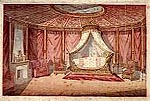 Château Malmaison has the air of a well-loved home but there is also a tangible strain of melancholy, summed up by the phrase used by the Emperor during his last visit to the château just before departing for his exile: “It’s so beautiful here at Malmaison! Is it not Hortense? (Genealogy) Wouldn’t it be nice to be able to stay here?”
Château Malmaison has the air of a well-loved home but there is also a tangible strain of melancholy, summed up by the phrase used by the Emperor during his last visit to the château just before departing for his exile: “It’s so beautiful here at Malmaison! Is it not Hortense? (Genealogy) Wouldn’t it be nice to be able to stay here?” On leaving the château, turn right onto the avenue du château de Malmaison and as the path forks immediately bear right onto the avenue Marmontel. Here you enter the private park of Malmaison which contains some of the most elegant dwellings of the town. Even though not part of our Napoleonic itinerary, it is difficult not to admire them. On the left, the mausoleum of the Prince Impérial (Genealogy) presents its moving silhouette. This small, circular temple, was erected in memory of the son of Napoleon III (Genealogy) and of the Empress Eugenie (Genealogy) tragically killed on a British colonial expedition in 1879. The monument here was built in 1938 as a replacement for the first mausoleum commissioned by the Empress Eugénie, but which had not withstood the test of time. This temple in stone and marble houses a bronze cast of the statue by Carpeaux of the Imperial Prince and his dog Nero.
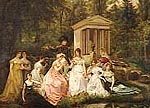 Continuing to the end of the avenue, you will notice on the left a large private house which has in the garden a monument that once belonged to the Malmaison Estate, that is the Temple of love. By peering through the gate (and ignoring the sign ‘Beware of the Dog’!), it is possible to see the edifice which Berthault built in 1807 onto a pre-existing smaller temple. The marble columns come from Parisian churches sacked during the Revolution and were added at Josephine’s express command. The statue of Cupid by Tassaert – which until 1877 stood under the cupola – is now held in the Museum of Château Malmaison.
Continuing to the end of the avenue, you will notice on the left a large private house which has in the garden a monument that once belonged to the Malmaison Estate, that is the Temple of love. By peering through the gate (and ignoring the sign ‘Beware of the Dog’!), it is possible to see the edifice which Berthault built in 1807 onto a pre-existing smaller temple. The marble columns come from Parisian churches sacked during the Revolution and were added at Josephine’s express command. The statue of Cupid by Tassaert – which until 1877 stood under the cupola – is now held in the Museum of Château Malmaison.The journey continues to the right, onto the avenue Delille. The land stretching from here to the avenue Napoléon Bonaparte (RN 13) is occupied by Little Malmaison, a former greenhouse built by Josephine as an outlet for her botanical passions. If you have made an appointment beforehand with the owner, it is possible to visit this charming site. If not, you will have to be content with looking through the gates and the dense foliage that borders the property.
For the more energetic, the itinerary can be continued by taking a beautiful walk to the Malmaison Estate forest, once a popular excursion for the Imperial entourage. To get there on foot, go back up the avenue Delille, take the avenue Ducis and then the rue de la Bergerie which leads directly to the Saint-Cucufa lake. But be warned, it is a steep climb! By car, on leaving the Malmaison Castle, take the avenue Tuck Stell. Then turn right onto the avenue de Versailles. When the Empress had guests, they were entertained for the most part with carriage rides here in the Malmaison forest and with boat rides on the lake. The last guest was Tsar Alexander of Russia in the month of May, 1814. The Empress Josephine passed away a few days after this visit.
-
Continuations
Saint-Cloud
Saint-Cloud was the site of the coup d’etat of Brumaire 18, year VIII ( November 9 and 10, 1799), but it was only after the announcement of his lifelong term as consulat in 1802, that Bonaparte settled into the castle. Erected after Mansart’s plans and finished in 1785, the Saint-Cloud Castle was the theater for a number of events in the history of France, notably under the First and Second Empires. Official residence of the First Consul from 1802 to 1804 then imperial residence, it was the site of the wedding of Napoleon and his second spouse, Marie-Louise, in 1810. In 1815, the surrender of Paris was signed there. Napoleon III was proclaimed emperor there in 1852, thus giving back to Saint-Cloud its vocation as imperial residence. The war was declared there July 15, 1870 and three months later, when the Empire ceased to exist, the castle and the town burned following a Prussian bombardment. The castle ruins were razed in 1891.
Today only the park, designed by Lenôtre, remains. The major attractions are the Great Cascade and the Horse Shoe Basin. The Balustrade lane leads to the Lantern Terrace which dominates Paris at a height of 94 meters. Napoleon had installed at this site a tower called the Lantern of Demosthenes, a copy of the monument to Lysicrate in Athens, which signaled the presence of the Emperor at Saint-Cloud when it was illuminated. This monument was also destroyed during the war of 1870. The historical museum of the Saint-Cloud Estate displays an evocation of this highly historic place and of the dynasties that succeeded one another there. Currently closed for renovation, it reopens its doors at the end of 1996.
Sèvres
Very close to Saint-Cloud stands the national factory of Sèvres and the National Ceramics Museum. In 1756, the Royal Porcelain Factory was moved from Vincennes to Sèvres. Meeting numerous difficulties under the Revolution, it was the Consulat that brought back all of its prestige by naming as director, in 1800, Alexandre Brongniard, son of the architect of the Stock Exchange. At the initiative of Vivant Denon, he called on a number of artists to furnish quality models and created the Ceramics Museum. The vestibule of the museum holds works of the epoch of the Empire among which is the famous Etruscan vase representing the arrival of the Italian works of art to the Napoleon Museum and of the series of plates coming from the service of the Swords and from the Olympic service.
-
Curiosity corner
Rueil Malmaison is above all known for the Malmaison Castle, mecca of the Napoleonic memory, but the richness of its history is not limited to the consular and imperial epochs. The name Rueil comes from a deformation of Ruel, name given because of the number of streets (rues) that crisscross the territory. The name Malmaison appeared following the Norman invasions that ravaged the surroundings. Its foundation during a distant epoch is attested to by neolithic vestiges. The establishment of a GalloRoman villa in the 1st Century A.D. bears witness to the first development of the site. The villa was replaced in the 6th Century by a Merovingian Dynasty estate. Actually, Childebert I, son of Clovis, and then Dagobert stayed at Rueil which would soon become their preferred residence. It was at this epoch that a fishing ground was created under the aegis of Charles Martel. In 875, the châtellenie of Ruel was offered by Charles the Bald to the abbey of SaintDenis which kept it until 1633, the date on which the religieux sold it to the cardinal of Richelieu.
It was during the 17th Century that Rueil started to acquire a little prosperity while growing in notoriety. By taking back in 1633 the castle of the Ruel valley, the cardinal of Richelieu transformed the modest village into a prized place of residence that attracted the celebrities of the epoch : Louis XIII, his brother Gaston of Orleans, Anne of Austria. The work engaged by Richelieu succeeded in realizing a magnificent estate composed of a castle, gardens, waterfalls, caves, ponds and an arch of triumph. This sumptuous collection surrounded the town center where the Saint PierreSaint Paul Church was also an object of work : the facade was reconstructed in 1635 after the plans of Lemercier, the architect of the Sorbonne.
It was at the Rueil Castle that the Treaty of Rueil was signed in 1635, placing the town of Colmar under the protection of France and the “Lettres patentes” authorizing the creation of the French Academy. In 1648, the royal court of the young Louis XIV and of his mother Anne of Austria settled at the castle to escape the Fronde. It was there that the “Paix de Ruel” was signed in 1649, putting an end this period of instability and of rebellion.
A few years later, Louis XIV proposed to buy the castle from the duchess of Aiguillon, niece of the cardinal of Richelieu. The asking price was so high that the king renounced his projects and decided to construct Versailles.
In 1800, Marshal Masséna became the owner and his descendents kept it until 1832. Then started the division of the estate which ended in the destruction of the castle. Today the only building still existing of this prestigious estate is the “Home of Father Joseph,” éminence grise of the cardinal who played a decisive role in foreign politics, notably in the struggle led against the Hapsburgs.In the 18th Century, Louis XV chose Rueil, along with Courbevoie and SaintDenis, as the site of the barrack buildings for the Swiss Guards. Of the three buildings, only the barracks of Rueil, constructed by Guillemot, exist today. Under the Consulat and the Empire, the consular and imperial guards occupied the structure. Under the Second Empire, the grenadiers of the guard regiments were housed there.
In the 19th Century, the first railroad line linking Paris to SaintGermainenLaye passed through Rueil. It was here that the Parisian strollers went in order to go to the Grenouillère on the isle of Croissy and the Fournaise Home, two places immortalized by the impressionists.
-
Bibliography
To know more about
Rueil Malmaison / Gérard Soncarrieu, Les Grandes Heures de Rueil-Malmaison, 1990 (on sale at the Tourist Office, 12 rue Paul Vaillant-Couturier. Here you will find other books covering the history of the city and many small souvenirs concerning Bonaparte, Josephine and the Malmaison Estate: drawings, etchings, porcelain pieces, historic figurines, etc.).
The Malmaison and Bois-Préau Castles / Gérard Hubert, Malmaison, RMN, 1989 ; Gérard and Nicole Hubert, Châteaux de Malmaison et Bois Préau, Paris, 1986
Nicole Hubert and Alain Pougetoux, Châteaux de Malmaison et de Bois-Préau. Musées napoléoniens de l’île d’Aix et de la maison Bonaparte à Ajaccio. Catalogue sommaire illustré des peintures et dessins, Paris, RMN, 1989
Bernard Chevallier, Malmaison, château et domaine des origines à 1904, Paris RMN, 1989
Bernard Chevallier, L’Abcdaire des châteaux de Malmaison et de Bois-Préau, Paris, Flammarion, 1997The Empire Style / Madeleine Deschamp, Empire, Editions Abbeville, Paris, 1994.
Josephine / Impératrice Joséphine, correspondance 1782-1814, edition established, presented and annotated by Bernard Chevallier, Maurice Catinat and Christophe Pincemaille, Histoire Payot, 1996.
Bernard Chevallier, L’Impératrice Joséphine, Livre de Poche, 1996.
Gérard Gougé-Martigneac, Michel Sementéry, La descendance de Joséphine, impératrice des Français, Editions Christian with the participation of the Fondation Napoléon, Paris, 1994.Botany and the art of gardens / Marie-Blanche d’Arneville, Parcs et jardins sous le Premier Empire, Tallandier, 1981.
L’Impératrice Joséphine et les sciences naturelles, catalogue of the exhibition organised by the Musée national du château de Malmaison, Paris, RMN, 1997
Pascale Delmotte, Malmaison 1799-1814. Un jardin d’agrément scientifique, typewritten mémoire de 2e cycle, Université Paris I Panthéon-Sorbonne
All of these works are on sale at the Malmaison Castle Museum bookstore as are a number of others dedicated to the Napoleonic Epic. Video cassettes, post cards, reproductions Redouté’s design boards, porcelain pieces and small busts of the Emperor and Empress, etc. are also available.
-
Map
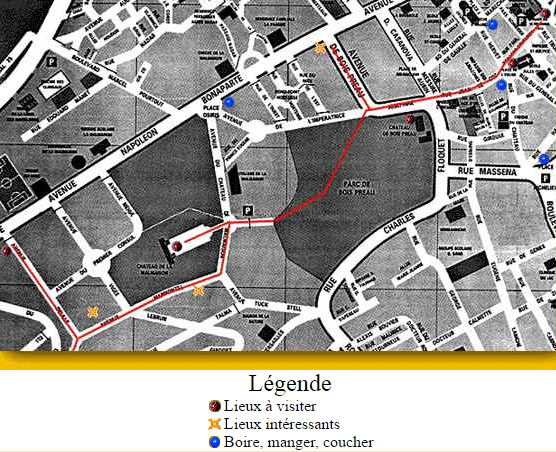
-
Practical information
Access
By car/ leaving Paris from Porte Maillot, take the R.N.13 passing by Défense, Puteaux and Nanterre ; at Rueil Malmaison, take the avenue Clémenceau (first left after the movie theaters) and continue to the town hall at the end of the street ; an underground parking facility allows for easy parking there.
By public transport/ RER line A “Rueil Malmaison” station then take bus n°144 or 467 in front of the station to the “Mairie” stop.
Taxis/ Taxi Radio of Rueil : 01 47 32 00 92 Taxi Station : 01 47 51 01 61
Rueil Malmaison
An invitation to visit Bonaparte, the First Consul, and his
lady wife Josephine at their beautiful home in Rueil-Malmaison.
lady wife Josephine at their beautiful home in Rueil-Malmaison.
